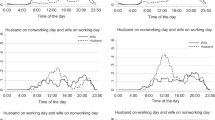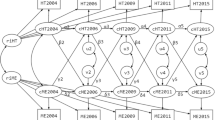Abstract
Prior research linking occupational sex composition (the proportion of women in an occupation) to housework has yielded conflicting results and relies exclusively on cross-sectional data. The present article extends scholarship on the gendered division of household labor by using longitudinal data from the Panel Study of Income Dynamics (PSID) 1981–2013 to assess how changes in occupational sex composition alter heterosexual married couples’ housework performance over time. I find that either spouse’s gender-atypical employment (e.g., husband’s employment in a predominately female job) is associated with gender-atypical housework performance by both spouses (e.g., higher housework hours for the husband and fewer hours for the wife). The association of women’s occupational sex composition with housework is driven by changes in individual women’s occupations and both spouses’ housework over time. In contrast, the association of men’s occupational sex composition with housework is driven by differences between different couples, not by within-couple change over time. Thus, fundamentally different causal mechanisms link women’s and men’s occupational sex composition to couples’ housework performance, and only for women are longitudinal changes in occupational sex composition associated with changes in housework. These findings have important implications for understanding occupation and housework as domains of gender performance.
Similar content being viewed by others
References
Bianchi, S. M., Milkie, M. A., Sayer, L. C., & Robinson, J. P. (2000). Is anyone doing the housework trends in the gender division of household labor. Social Forces, 79(1), 191–228. doi:10.2307/2675569.
Bittman, M., England, P., Sayer, L., Folbre, N., & Matheson, G. (2003). When does gender trump money? Bargaining and time in household work. American Journal of Sociology, 109(1), 186–214. doi:10.1086/378341.
Brines, J. (1994). Economic dependency, gender, and the division of labor at home. American Journal of Sociology, 100(3), 652–688. doi:10.1086/230577.
Bryan, M. L., & Sevilla-Sanz, A. (2011). Does housework lower wages? Evidence for Britain. Oxford Economic Papers, 63(1), 187–210. doi:10.1093/oep/gpq011.
Cejka, M. A., & Eagly, A. H. (1999). Gender-stereotypic images of occupations correspond to the sex segregation of employment. Personality and Social Psychology Bulletin, 25, 413–423.
Dodson, T. A., & Borders, L. D. (2006). Men in traditional and nontraditional careers: Gender role attitudes, gender role conflict, and job satisfaction. Career Development Quarterly, 54(4), 283–296. doi:10.1002/j.2161-0045.2006.tb00194.x.
England, P. (1992). Comparable worth: Theories and evidence. New York: Aldine.
England, P. (2010). The gender revolution: Uneven and stalled. Gender & Society, 24(2), 149–166. doi:10.1177/0891243210361475.
England, P. (2015). Sometimes the social becomes personal: Gender, class, and sexualities. American Sociological Review, 81(1), 4–28. doi:10.1177/0003122415621900.
England, P., Herbert, M., Kilbourne, B., Reid, L. L., & Megdal, L. M. (1994). The gendered valuation of occupations and skills: Earnings in 1980 census occupations. Social Forces, 73(1), 65–100. doi:10.2307/2579918.
England, P., Reid, L. L., & Kilbourne, B. S. (1996). The effect of the sex composition of jobs on starting wages in an organization: Findings from the NLSY. Demography, 33(4), 511–521. doi:10.2307/2061784.
Evertsson, M., & Nermo, M. (2004). Dependence within families and the division of labour: Comparing Sweden and the United States. Journal of Marriage and the Family, 66(Dec), 1272–1286. doi:10.1111/j.0022-2445.2004.00092.x.
Evertsson, M., & Nermo, M. (2007). Changing resources and the division of housework: A longitudinal study of Swedish couples. European Sociological Review, 23(4), 455–470. doi:10.1093/esr/jcm018.
General Social Survey (GSS). (2017, May 31). The general social survey. Chicago, IL: NORC at the Univerisity of Chicago. Retrieved from http://gss.norc.org/.
Gough, M. (2011). Unemployment in families: The case of housework. The Journal of Industrial Economics, 59(3), 1085–1100. doi:10.1111/j.1741-3737.2011.00867.x.
Greenstein, T. N. (2000). Economic dependence, gender, and the division of labor in the home: A replication and extension. Journal of Marriage and Family, 62(2), 322–335. doi:10.1111/j.1741-3737.2000.00322.x.
Gupta, S. (2006). Her money, her time: Women’s earnings and their housework hours. Social Science Research, 35(4), 975–999. doi:10.1016/j.ssresearch.2005.07.003.
Gupta, S. (2007). Autonomy, dependence, or display? The relationship between married women’s earnings and housework. Journal of Marriage and Family, 69(2), 399–417. doi:10.1111/j.1741-3737.2007.00373.x.
Gupta, S., & Ash, M. (2008). Whose money, whose time? A nonparametric approach to modeling time spent on housework in the United States. Feminist Economics, 14(1), 93–120. doi:10.1080/13545700701716664.
Harding, T. (2007). The construction of men who are nurses as gay. Journal of Advanced Nursing, 60(6), 636–644. doi:10.1111/j.1365-2648.2007.04447.x.
Heilman, M. E., & Okimoto, T. G. (2007). Why are women penalized for success at male tasks?: The implied communality deficit. Journal of Applied Psychology, 92(1), 81–92. doi:10.1037/0021-9010.92.1.81.
Heilman, M. E., & Wallen, A. S. (2010). Wimpy and undeserving of respect: Penalties for men’s gender-inconsistent success. Journal of Experimental Social Psychology, 46(4), 664–667. doi:10.1016/j.jesp.2010.01.008.
Hook, J. L. (2017). Women’s housework: New tests of time and money. Journal of Marriage & Family, 79(February), 179–198. doi:10.1111/jomf.12351.
Killewald, A., & Gough, M. (2010). Money isn’t everything: Wives’ earnings and housework time. Social Science Research, 39(6), 987–1003. doi:10.1016/j.ssresearch.2010.08.005.
Kmec, J. A., McDonald, S., & Trimble, L. B. (2010). Making gender fit and “correcting” gender misfits: Sex segregated employment and the nonsearch process. Gender & Society, 24(2), 213–236. doi:10.1177/0891243209360531.
Lachance-Grzela, M., & Bouchard, G. (2010). Why do women do the lion’s share of housework? A decade of research. Sex Roles, 63(11), 767–780. doi:10.1007/s11199-010-9797-z.
Mattingly, M. J., & Bianchi, S. M. (2003). Gender differences in the quantity and quality of free time: The U. S. experience. Social Forces, 81, 999–1030. doi:10.1353/sof.2003.0036.
McClintock, E. A. (2014). Beauty and status: The illusion of exchange in partner selection? American Sociological Review, 79(4), 575–604. doi:10.1177/0003122414536391.
McClintock, E. A. (2016). Occupational Sex Segregation and Marriage: The Romantic Cost of Gender-Deviant Jobs. Working Paper.
McClintock, E. A. (2017). Occupational sex composition and gendered housework performance: Compensation or conventionality? Journal of Marriage & Family, 79(2), 475–510. doi:10.1111/jomf.12381.
Neuhaus, J. M., & Kalbfleisch, J. D. (1998). Between- and within-cluster covariate effects in the analysis of clustered data. Biometrics, 54(2), 638–645. doi:10.2307/3109770.
Neuhaus, J. M., & McCulloch, C. E. (2006). Separating between- and within-cluster covariate effects by using conditional and partitioning methods. Journal of the Royal Statistical Society. Series B (Statistical Methodology), 68(5), 859–872. doi:10.1111/j.1467-9868.2006.00570.x.
Noonan, M. C. (2001). The impact of domestic work on men’s and women’s wages. Journal of Marriage and Family, 63(4), 1134–1145. doi:10.1111/j.1741-3737.2001.01134.x.
Okamoto, D., & England, P. (1999). Is there a supply side to occupational sex segregation? Sociological Perspectives, 42(4), 557–582. doi:10.2307/1389574.
Panel Study of Income Dynamics (PSID). (2016). A national study of socioeconomics and health over lifetimes and across generations. Retrieved from https://psidonline.isr.umich.edu.
Parkman. (2004). Bargaining over housework: The frustrating situation of secondary wage earners. Journal of Economics, 63(4), 765–794. doi:10.1111/j.1536-7150.2004.00316.x.
Parrott, H. M. (2014). Housework, children, and women’s wages across racial-ethnic groups. Social Science Research, 46, 72–84. doi:10.1016/j.ssresearch.2014.02.004.
Perales, F., & Vidal, S. (2015). Looking inwards: Towards a geographically sensitive approach to occupational sex segregation. Regional Studies, 49(4), 582–598.
Petersen, T., & Morgan, L. A. (1995). Separate and unequal: Occupation-establishment sex segregation and the gender wage gap. American Journal of Sociology, 101(2), 329–365. doi:10.1086/230727.
Royston, P. (2004). Multiple imputation of missing values. Stata Journal, 4(3), 227–241.
Ruggles, S., Alexander, J. T., Genadek, K., Goeken, R., Schroeder, M. B., & Sobek, M. (2010). Integrated public use microdata Series: Version 5.0 [machine-readable database]. Minneapolis: University of Minnesota.
Schneider, D. (2011). Market earnings and household work: New tests of gender performance theory. Journal of Marriage and Family, 73(4), 845–860. doi:10.1111/j.1741-3737.2011.00851.x.
Schneider, D. (2012). Gender deviance and household work: The role of occupation. American Journal of Sociology, 117(4), 1029–1072. doi:10.1086/662649.
Stratton, L. S. (2001). Why does more housework lower women’s wages? Testing hypotheses involving job effort and hours flexibility. Social Science Quarterly, 82(1), 67–76. doi:10.1111/0038-4941.00007.
Tomaskovic-Devey, D. (1993). Gender and racial inequality at work: The sources and consequences of job segregation. Ithaca: ILR Press.
Williams, C. L. (1989). Gender differences at work: Women and men in nontraditional occupations. Berkeley: University of California Press.
Acknowledgements
I would like to thank Emily Fitzgibbons Shafer for her comments and advice.
Author information
Authors and Affiliations
Corresponding author
Electronic supplementary material
ESM 1
(DOCX 60 kb)
Rights and permissions
About this article
Cite this article
McClintock, E.A. Changing Jobs and Changing Chores? The Longitudinal Association of Women’s and Men’s Occupational Gender-Atypicality and Couples’ Housework Performance. Sex Roles 78, 165–181 (2018). https://doi.org/10.1007/s11199-017-0794-3
Published:
Issue Date:
DOI: https://doi.org/10.1007/s11199-017-0794-3




